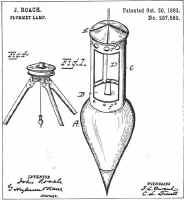 Article taken from "Backsights"
Magazine published by Surveyors Historical Society
Article taken from "Backsights"
Magazine published by Surveyors Historical Society |
CALIFORNIA
PLUMMET-LAMP
by Dale Beeks
 Of the varied forms of plumb bobs,
one of the most unusual designs, the plummet-lamp, was adapted for use in
underground mining and tunnel surveys. The purpose of the plummet-lamp was
to provide an illuminated target for the surveyor/engineer conducting his work
underground. Unlike above-ground surveying, backsight and forsight
stations in underground surveys were placed in the ceiling (as constant work
would obliterate points in the floor). In use, the plummet-lamp was
suspended from a station spad in the ceiling and the wick (fed from a fuel font
within the hollowed body of the plummet) was ignited. The instrument man
then had an easily sightable illuminated point. Of the varied forms of plumb bobs,
one of the most unusual designs, the plummet-lamp, was adapted for use in
underground mining and tunnel surveys. The purpose of the plummet-lamp was
to provide an illuminated target for the surveyor/engineer conducting his work
underground. Unlike above-ground surveying, backsight and forsight
stations in underground surveys were placed in the ceiling (as constant work
would obliterate points in the floor). In use, the plummet-lamp was
suspended from a station spad in the ceiling and the wick (fed from a fuel font
within the hollowed body of the plummet) was ignited. The instrument man
then had an easily sightable illuminated point.
The conventional plummet-lamp
incorporated a heavy inverted brass cone with an internal fuel font and exposed
wick, suspended in a gimbaled ring, the latter held at two points of attachment
by a suspension chain. This from exposed the lamp wick and flame, to wind
currents and dripping ceilings; its operation is not too efficient in some mine
surveying applications.
A unique design of plummet lamp
evolved from the shop of San Francisco instrument manufacturer John Roach
(1813-1891). Roach's design incorporated a brass hood and a mica or glass
chimney that protected the flame from both wind currents and water drips from
the ceiling; a lantern atop a plummet. The design evolved sometime in the
late 1870's and in 1883 was awarded a silver metal from the Mechanics'
Institute. It was patented by Roach on October 30, 1883 and continued
being marketed by Roach's successor J. C. Sala until at least 1894. This
from of plummet-lamp is very rare today. Possibly because Roach and Sala
were the only maker/suppliers of this patent form. We are aware of only
one example of this patent plummet-lamp. It is a pre-patent example
signed, "J. Roach S. F. Cal., Pat. Appl'd for".
|
